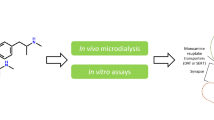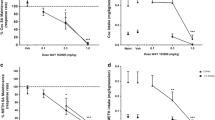Abstract
Electrophysiological and cytofluorometric data suggest that doses of amphetamine which enhance locomotor activity and promote focused stereotypies produce pronounced effects on serotonin pathways in the CNS. However, the biochemical evidence regarding changes in serotonergic function produced by moderate doses of this drug is inconsistent. Therefore, the present study was designed to further examine the effects of amphetamine (1–5 mg/kg) on regional brain serotonin and its metabolite and to compare these effects to behaviorally comparable doses of methylphenidate and apomorphine. At doses which produce a multiphasic behavioral response pattern, including a stereotypy phase consisting primarily of repetitive head movements and occasional oral stereotypies, amphetamine (3 mg/kg) and methylphenidate (30 mg/kg) increased levels of 5HIAA in striatum and frontal cortex, two brain regions which receive serotonergic projections from the dorsal raphe nucleus. In contrast, these drugs decreased or had no effect on 5HIAA levels in hippocampus, a brain region which receives its serotonergic innervation from the median raphe nucleus. A moderate dose of apomorphine (0.5 mg/kg) produced a comparable pattern of neurochemical effects. These data are consistent with electrophysiological and cytofluorometric data suggesting enhanced dorsal raphe serotonergic function following amphetamine-like stimulants. Pretreatment of animals with α-methyltyrosine at a dose sufficient to prevent the locomotor stimulation and stereotypy promoted by amphetamine, or by haloperidol, failed to prevent the amphetamine-induced increase in 5HIAA, indicating that these serotonergic effects are not secondary to the amphetamine facilitation of dopaminergic transmission. The results of this study suggest that serotonin may play a modulatory role in the behavioral effects of amphetamine-like stimulants which is dependent for its expression on an intact dopamine system.
Similar content being viewed by others
Abbreviations
- DA:
-
dopamine
- AMPH:
-
S(+)amphetamine
- 5HT:
-
serotonin
- MP:
-
methylphenidate
- APO:
-
apomorphine
- 5HIAA:
-
5-hydroxyindoleacetic acid
- αMT:
-
α-methyltyrosine
- DOPAC:
-
3,4-dihydroxyphenylacetic acid
- HVA:
-
homovanillic acid
- HAL:
-
haloperidol
References
Azmitia EC (1978) The serotonin-producing neurones in the mid-brain media and dorsal raphé nuclei. Handbook of Psychopharmacology, vol. 9
Baraban JM, Wang RY, Aghajanian GK (1978) Reserpine suppression of dorsal raphé neuronal firing: mediation by adrenergic system. Eur J Pharmacol 52:27–36
Boadle-Biber MC, Johannessen JN, Narasimhachari N, Phan T-H (1983) Activation of tryptophan hydroxylase by stimulation of central serotonergic neurons. Biochem Pharmacol 32:185–188
Bobillier P, Petitjean F, Salvert D, Ligier M, Seguin S (1975) Differential projections of the nucleus raphé dorsalis and nucleus raphé centralis as revealed by autoradiography. Brain Res 85:205–210
Bobillier P, Seguin S, Petitjean F, Salvert D, Touret M, Jouvet M (1976) The raphé nuclei of the cat brain stem: A topographical atlas of their efferent projections as revealed by autoradiography. Brain Res 113:449–486
Breese GR, Cooper BR, Mueller RA (1974) Evidence for involvement of 5-hydroxytryptamine in the actions of amphetamine. Br J Pharmacol 52:307–314
Bunney BS, Aghajanian GK (1976) The precise localization of nigral afferents in the rat as determined by a retrograde tracing technique. Brain Res 117:423–435
Cole SO (1978) Brain mechanisms of amphetamine-induced anorexia, locomotion and stereotypy: A review. Neurosci Biobehav Rev 2:89–100
Costall B, Naylor RJ (1974) Stereotyped and circling behavior induced by dopaminergic agonists after lesions of the midbrain raphé nuclei. Eur J Pharmacol 29:206–222
Fernando JCR, Lees AJ, Curzon G (1980) Differential antagonism by neuroleptics of backward-walking and other behaviors caused by amphetamine at high dosage. Neuropharmacology 19:549–553
Fibiger HC, Miller JJ (1977) An anatomical and electrophysiological investigation of the serotonergic projection from the dorsal raphé nucleus to the substantia nigra in the rat. Neuroscience 2:975–987
Foote W, Sheard M, Aghajanian GK (1969) Comparison of LSD and amphetamine on midbrain raphé units. Nature 222:567–569
Fuxe K, Ungerstedt U (1968) Histochemical studies on the effect of (+)-amphetamine, drugs of the imipramine group, and tryptamine on central catecholamine and 5-hydroxytryptamine neurons after intraventricular injection of catecholamine and 5-hydroxytryptamine. Eur J Pharmacol 4:135–144
Fuxe K, Hamberger B, Malmfors T (1967) The effect of drugs on accumulation of monoamines in tuberoinfundibular dopamine neurons. Eur J Pharmacol 1:334–342
Gallager DW, Aghajanian GK (1976) Effect of antipsychotic drugs on the firing rate of dorsal raphé cells. I. Role of adrenergic system. Eur J Pharmacol 39:341–355
Geyer MA, Dawsey WJ, Mandell AJ (1975) Differential effects of caffeine, D-amphetamine and methylphenidate on individual raphé cell fluorescence: a microspectro-fluorimetric demonstration. Brain Res 106:241–256
Geyer MA, Puerto A, Dawsey WJ, Knapp S, Bullard WP, Mandell A (1976) Histologic and enzymatic studies of the mesolimbic and mesostriatal serotonergic pathways. Brain Res 106:241–256
Jacobs BL, Wise WD, Taylor KM (1974) Differential behavior and neurochemical effects following lesions of the dorsal or median raphé nuclei in rats. Brain Res 79:353–361
Kelley PH (1977) Drug-induced motor behavior. Handbook of Psychopharmacology, vol. 8
Kuczenski R (1983) Biochemical actions of amphetamine and other stimulants. In: Creese I (ed) Stimulants: neurochemical, behavioral and clinical perspectives. Raven, New York, pp 31–61
Kuczenski R, Segal DS (1975) Differential effects of d- and 1-amphetamine and methylphenidate on rat striatal dopamine biosynthesis. Eur J Pharmacol 30:244–251
Lees AJ, Fernando JCR, Curzon G (1979) Serotonergic involvement in behavioral response to amphetamine at high dosage. Neuropharmacology 18:153–158
Lee EHY, Geyer MA (1982) Selective effects of apomorphine on dorsal raphé neurons: a cytofluorometric study. Brain Res Bull 9:719–725
Lee EHY, Geyer MA (1984) Dopamine autoreceptor mediation of the effects of apomorphine on serotonin neurons. Pharmacol Biochem Behav 21:301–311
Lorens SA, Guldberg HC (1974) Regional 5-hydroxytryptamine following selective midbrain raphé lesions in the rat. Brain Res 78:45–56
Lucki I, Harvey JA (1979) Increased sensitivity to d- and 1-amphetamine action after midbrain raphé lesions as measured by locomotor activity. Neuropharmacology 18:243–249
Mabry PD, Campbell BA (1973) Serotonergic inhibition of catecholamine-induced behavioral arousal. Brain Res 49:381–391
Magnusson O, Nilsson LB, Westerlund D (1980) Simultaneous determination of dopamine, DOPAC and homovanillic acid. J Chromatogr 221:237–247
Miller JJ, Richardson TL, Fibiger HC, McLennan H (1975) Anatomical and electrophysiological identification of a projection from the mesencephalic raphé to the caudate putamen in the rat. Brain Res 97:133–138
Neill DB, Grant LD, Grossman SP (1972) Selective potentiation of locomotor effects of amphetamine by midbrain raphé lesions. Physiol Behav 9:655–657
Pasquier DA, Kemper TC, Forbes WB, Morgane PJ (1977) Dorsal raphé, substantia nigra and locus coeruleus: interconnections with each other and the neostriatum. Brain Res Bull 2:323–339
Raiteri M, Del Carmine R, Bertollini A, Levi G (1973) Effect of sympathomimetic amines on the synaptosomal transport of noradrenaline dopamine and 5-hydroxytryptamine. Eur J Pharmacol 41:133–143
Rebec GV, Segal DS (1980) Apparent tolerance to some aspects of amphetamine stereotypy with long-term treatment. Pharmacol Biochem Behav 13:793–797
Rebec GV, Curtis SD (1983) Reciprocal changes in the firing rate of neostriatal and dorsal raphé neurons following local infusions or systemic injections of d-amphetamine. Evidence for neostriatal heterogeneity. J Neurosci 3:2240–2250
Ross SB, Ogren S-O, Renyi AL (1977) Substituted amphetamine derivatives. I. Effect on uptake and release of biogenic monoamines and on monoamine oxidase in the mouse brain. Acta Pharmacol Toxicol 41:337–352
Schubert J, Sedvall G (1972) Effect of amphetamines on tryptophan concentrations in mice and rats. J Pharm Pharmacol 24:53–62
Segal DS (1976) Differential effects of para-chlorophenylalanine on amphetamine-induced locomotion and stereotypy. Brain Res 116:267–276
Segal DS, Kuczenski R (1974) Tyrosine hydroxylase activity: Regional and subcellular distribution in brain. Brain Res 68:261–266
Segal DS, Weinberger SB, Cahill JC, McCunney S (1980) Multiple daily amphetamine administration: behavioral and neurochemical alterations. Science 207:904–907
Skirboll LR, Grace AA, Bunney BS (1979) Dopamine auto-and postsynaptic receptors: electrophysiological evidence for differential sensitivity to dopamine agonists. Science 206:80–82
Sloviter RS, Drust EG, Connor JD (1978a) Specificity of a rat behavioral model for serotonin receptor activation. J Pharmacol Exp Ther 206:339–347
Sloviter RS, Drust EG, Connor JD (1978b) Evidence that serotonin mediates some behavioral effects of amphetamine. J Pharmacol Exp Ther 206:348–352
Tagliamonte A, Tagliamonte P, Perez-Cruet J, Stern S, Gessa GL (1971) Effect of psychotropic drugs on tryptophan concentrations in the rat brain. J Pharmacol Exp Ther 177:475–480
Waldmeier PC, Buckle H-M, Stoecklin K, Fehr B, Feldtrauer J-J (1983) The effects of amfonelic acid on 5HT metabolism in rat brain. J Neural Transm 57:149–165
Author information
Authors and Affiliations
Rights and permissions
About this article
Cite this article
Kuczenski, R., Segal, D.S., Leith, N.J. et al. Effects of amphetamine, methylphenidate, and apomorphine on regional brain serotonin and 5-hydroxyindole acetic acid. Psychopharmacology 93, 329–335 (1987). https://doi.org/10.1007/BF00187252
Received:
Revised:
Issue Date:
DOI: https://doi.org/10.1007/BF00187252




